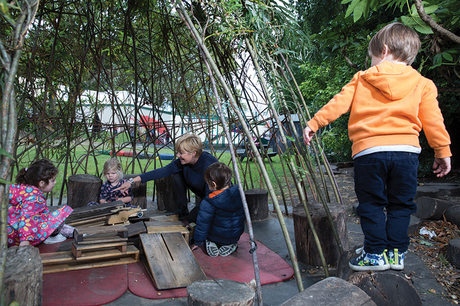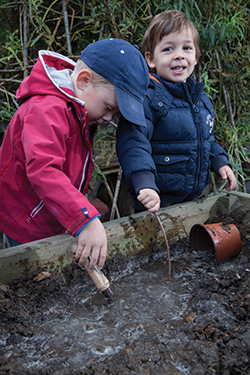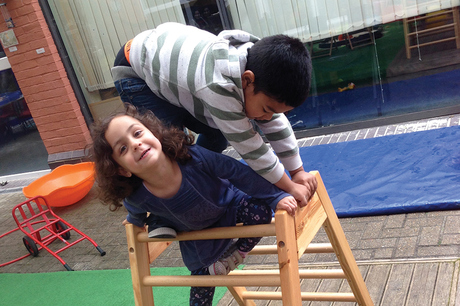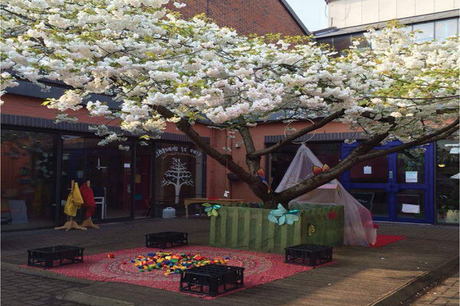
Children’s delight in their own unrestricted, exuberant physicality is a joy to witness: hair full of grass and sticks; rosy cheeks aching from laughing; and limbs swinging with the sheer exhilaration of movement. At least, that’s how it should be.
For some children, opportunities to revel in the outdoors are irregular and infrequent, and the reasons are many and complex. Time pressures on family life, distances from open spaces and fear of injury (or litigation) are just a few explanations given when parents and settings recognise they are neglecting outdoor play.
- Over the past year, I’ve worked with 20 settings in Newham, east London, to devise and test simple, cost-effective ways to increase the frequency and regularity of children’s vigorous movements. Also involved were Early Education associate Jan White and movement specialist Jasmine Pasch. Together, we speculated about what a truly thrilling outdoor space for movement would look like and, happily, found significant areas of agreement – that a space should:
- be free of clutter
- enable and encourage running, leaping, rolling and risk-taking
- have natural elements
- offer variation in levels, textures and micro-climate
- be flexible, so children can change the space and its resources.
AUDIT
Participants observed children playing outdoors at various times of the day and on different days of the week. They also recorded which resources children chose to play with and where and how many children were involved in each observed episode of play. Some participants, familiar with the Leuven scales for well-being and involvement, included these in their audit.
Our key audit tool was inspired by Jasmine Pasch’s ‘Boing Whoosh RolyPoly’ model and invited practitioners to seek examples of these kinds of movement, along with those of proprioception. They then analysed the audit to identify gaps in provision.
As a result of the initial auditing, practitioners became interested in the physicality of children’s upper bodies, with some choosing it as a focus for their action research projects. They pointed out that as children progressed from crawling and cruising to walking and running, they appeared to place less emphasis on play using the big muscle groups in the upper back and shoulders, instead enjoying the newfound power of their legs and hips.
SIMPLE SOLUTIONS
With no new capital budget for the programme, it was imperative that the action research projects used low- or no-cost interventions, so that they could be implemented immediately and the impact measured within the lifetime of the programme. In effect, this meant settings using their existing spaces, resources and budgets in the most effective way possible.
Loose parts
Whilst all participants were familiar with the theory of loose parts and used them in their settings, most had not considered the role of loose parts in improving gross motor skills, or as part of a targeted effort to improve children’s core strength, resilience, balance or flexibility. Using vestibular motion and the proprioceptive sense as our twin foci, we revisited loose parts as tools to build these important elements of physicality.
Small interventions
Small interventions in the form of resources, landscaping and management tweaks can have a substantial and sustainable impact on the potential of an early years outdoor landscape (whatever its size). The Outdoors and Active team collated this list of movement-rich features:
Boing: level changes to encourage jumping from different heights (including ‘scary’ heights that children can work towards conquering); tree climbing; netball hoop; overhead space for children to reach and jump upwards; railings and poles to hang from (including upside down); soft, springy or bouncy surfaces; fixed or portable climbing equipment for jumping from.
Whoosh: mounds and hills; clear space to run or pedal straight through; obstacles to run or pedal around; rocking objects such as play equipment or deliberately unstable surfaces; tyre swing; wheeled vehicle track, particularly including inclines and rough surfaces.
RolyPoly: rotating and spinning objects; railings and poles for twirling round; mounds for rolling down (or up!); objects for pushing and pulling.
Proprioception: nooks and crannies to negotiate; obstacles to move around and over; storage that requires full-body movements to access; a wide variety of surface treatments to test balance and co-ordination (especially at speed) – for example, grass, dirt, mud, bark chips, textured slabs, rubber, concrete, cobbles, gravel, rocks a nd stones, decking, brick paviors, sand, shallow water, low shrubs/aromatic ground cover.
nd stones, decking, brick paviors, sand, shallow water, low shrubs/aromatic ground cover.
Children’s ability to perceive depth, motion and perspective are becoming more acute at this age, and several settings reported children being more aware of the shape and size of their outdoor space, and the position of objects in it, after proprioception activities were prioritised.
While the Boing Whoosh RolyPoly approach helped practitioners focus on vestibular motion, the action researchers also linked a range of movements to a child’s health and well-being (see below).
HEALTH AND SAFETY
The importance of risk-taking was widely discussed, with the Health and Safety Executive’s statement on striking a balance in children’s play providing context and reassurance.
In considering how best to introduce new resources and activities, we first detailed the benefits children would gain, taking into account physical and intellectual and emotional development. Only then did we look at the potential risks attached to the activity or resource. The Risk Benefit approach was developed to enable risky and challenging activity.
Example: a tyre swing
Activity: Installing and using swing.
Benefits:Core strength; balance and co-ordination; risk-taking.
Risks: Snapped branch; scratches from tyre; injury from fall or collision.
Mitigation:Check branch can take the weight of tyre and an adult’s weight; check strength of branch weekly; check quality of tyre – discard if any wires become visible; use appropriate knot or fixing to attach rope to tyre; adjust height of tyre to ensure maximum fall height is appropriate to age and height of children; provide soft surface below; place rope out of reach when not attached to the tyre.
Risk rating: Low.
Download our Risk Benefit Assessment template.
CASE STUDY: IMAAN PRE-SCHOOL

Imaan is a sessional, pack-away pre-school based in a community centre in Newham. The tiny outdoor space that it uses, alongside the pack-away requirement, limits how physically active children can be outdoors.
Nevertheless, managers Antje Dragoni-Ouni and Sarah Atchoum embraced the project and began with a visioning exercise in which the whole team collaborated on a statement that would set the direction for physicality in their setting: ‘Outdoors is special and unique. Movement is the child’s first language and we value children’s intrinsic joy in movement and mastering physical skills outdoors. We actively and enthusiastically support, challenge and plan for movement in all weathers and all year round to instil a lifelong love of activity and movement outdoors.’
Their initial audit identified several areas for improvement:
Lack of greenery: provide more opportunities to interact with green space and natural materials.
Cramped and limited space: organise and zone the space to allow the children to be more energetic.
Daily chore of packing away: make it more manageable by involving the children.
Limited opportunities to take physical risks: strategies to allow boisterous and challenging play could reduce frustrations and conflict.

Imaan Pre-School before the changes
With such limited space and immovable objects (such as a tree), it meant that the setting looked to loose parts as a means of increasing children’s activity levels. An effective campaign of ‘begging and borrowing’ resulted in the acquisition of crates, logs, breeze blocks, sticks, pallets, stones and a giant elastic ‘scrunchie’. Fundraising events with parents yielded £500, which was spent on movement-specific items: a vestibular ‘dish’, a portable timber bridge, gardening and mud kitchen tools and equipment.
Volunteers helped reorganise the space to allow for greater freedom of movement, and in the process created a messy/mud play area and a gardening area tucked into previously awkward nooks, and attached a rope swing to the tree. A revamp of storage gives children easy access to the new gardening and tidying-up equipment, playing a meaningful – and physically demanding – role in the daily routines of the setting.
Ms Dragoni-Ouni says, ‘We’ve observed that children are more physically active now there is more unrestricted space to move around in, and now we as adults are more understanding of the children’s need to “boing, whoosh and roly-poly” their bodies. We are limited by the space we have, but children are inspired by the new loose parts resources and are using them collaboratively to develop their proprioception as well as physical skills. Our wishlist includes a walk in sandpit and access to the tree (which is fenced off), but I’m not sure these will ever be possible in our space. Instead, we’re making greater use of the parks and spaces around us, including within our own building – simply taking children up and down the stairs has been a novelty and has definitely left them puffed-out and rosy-cheeked.’
MAKING MOVES
British Heart Foundation advocates 180 minutes of physical activity over the course of each day. Handily, these movements include commonplace tasks such as walking upstairs, walking to school and kicking a ball about. Using Jasmine Pasch’s ‘Boing Whoosh RolyPoly’ model, the Outdoors and Active action researchers identified movements they considered indicators of confident, happy and healthy children, and tested ways to encourage these actions.
MOVEMENT TYPE AND RESOURCES TESTED
Spinning on the spot Gymnastic ribbon sticks, circles of chalk, bubbles, hula hoops
Rolling forwards, backwards, on side Mounds, hollow block slopes, water slide
Stepping up and down Steps and stairs, kerbs, planting boxes, hollow blocks, logs
Balancing Logs, kerbstones, ledges, chalk lines or a rope on the ground
Taking giant or tiny steps Paving slabs, chalk markson the ground, stepping stones, wrapping children’s feet in bubble wrap
Throwing/flinging with one or two hands Squishy rubber balls, textured objects, ball with bell inside, scarves and floaty fabric, ball with a ‘tail’
Pushing and pulling Wheeled vehicles, weaving with awkward objects
Leaping Music, drums, mini-Olympics
Bouncing and jumping with two legs together French skipping elastics, role-play hopping animals
Walking in bare feet Everywhere – seek unusual or challenging textures, including puddles; also try guided blindfold walks
Hanging upside down and lifting own bodyweight Bike racks, fences, strong tree branches, rope strung between poles, tyre swing
Repeating any movement Praise what you see, model the movement
Building and demolishing Dens, hollow blocks, real bricks, guttering
Running on level, sloped and uneven ground Open space – uncluttered by other objects, routes marked through cluttered and uneven ground, dressing-up items (e.g. cloaks)
Skipping Ropes, French skipping elastics, music/drums
Waving Flags, gymnastic ribbons, bubbles, cheerleader pompoms, magic wands
Crouching, springing and crawling Changes of levelto encourage jumping, tunnels made from sticksand blankets, hollows in shrubby areas
Bending, stretching and twisting Scavenger hunt, irresistible stimuli placed around the garden – in trees, under tables, behind the shed; back scratchers
Whole-arm movements Traditional rhyme games, musical instruments, counting games, linking arms with friends, simple sign language
Arm resistance and carrying heavy or awkward objects Physiotherapy ‘therabands’ (synthetic rubber strips), home-made slingshots, setting up and clearing up the outside space; accessible storage, bottle babies
Climbing and stepping Ropes, ladders, traverse wall, trees, fences, stairs and steps.
PRACTICE POINTS
Benefit risk assessment for new activities and resources (e.g. planks of wood, tree-climbing).
Create discrete spaces for different kinds of physical activity so that vigorous movement doesn’t interfere with quieter play.
Ensure outdoors is always available so that children who need to move, urgently, can do so.
All staff dressed appropriately for outdoors.
Accessible storage so children can be active in setting up and clearing up each day.
Understand the appeal of ‘alternative’ spaces and places for movement.
Adults participate in active play, model movements and are playful.
Share children’s joy in physicality with their parents and carers.
Practise making movements – e.g. landing safely with bent legs when jumping.
Actively encourage children to use resources in new and challenging ways, and to move around the space at speed.
Staff meeting to discuss and agree a statement about the importance of physical development and physicality.
Allocate small budgetto replenish ‘free and found’ objects (from charity shops, pound shops, scrap store, etc).
MORE INFORMATION
Loose Parts: Inspiring Play in Young Children by Lisa Daly and Miriam Beloglovsky (Redleaf Press 2014)
‘On the loose’ by Nicole Weinstein, Nursery World, May 2014
‘Going strong’ by Julie Mountain, Nursery World, May 2013
The Well Balanced Child by Sally Goddard Blythe (HawthornPress 2014)
100 Ideas for Early Years Practitioners: Outdoor Play by Julie Mountain (Bloomsbury 2015)
The Boing Whoosh RolyPoly audit sheet to help you identify gaps in and plan for movement play Boing Whoosh observation sheet
Health and Safety Executive: High Level Statement – Striking A Balance, www.tinyurl.com/HSEplay
British Heart Foundation guidance, www.tinyurl.com/BHFwalkers and www.tinyurl.com/BHFnonwalkers









